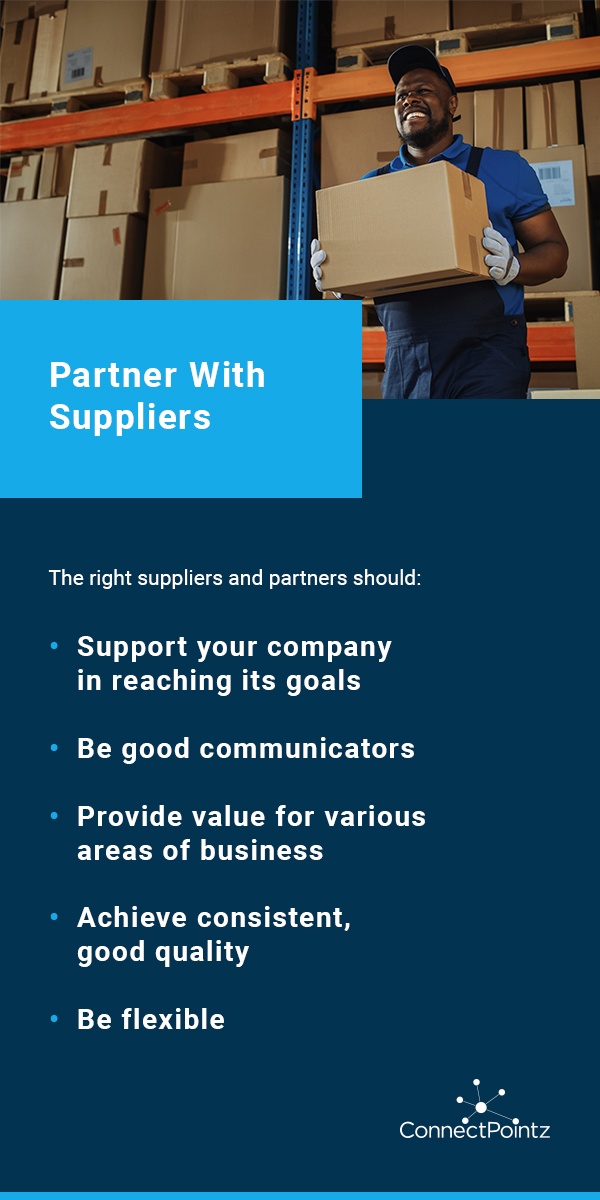
Supply chain management is one of the more complex parts of running a business, especially in a globalized landscape. It's made many supply chain managers realize they need to prepare for issues before they happen by strengthening the supply chain. You can improve your supply chain's efficiency, reliability, flexibility and other qualities to better weather the fluctuations of the industry and provide better results to customers and shareholders.
So, what can you do to improve your supply chain and gain a competitive advantage?
7 Ways to Improve Your Supply Chain Strategy
Successful supply chains achieve strong performance across many different areas, from supplier relationships to data visibility. In each of these areas, your supply chain strategy should align with your overall business strategy and move in sync with the company's primary plans. Ideally, supply chain teams should be involved in these discussions to contribute and take information back to support methods on their side of the company.
With that in mind, let's look at some more specific ways you can improve your supply chain management strategy.
- Optimize Inventory: Streamline inventory management to reduce costs and improve fulfillment speed.
- Improve Your Distribution Network: Strengthen delivery systems for faster and more reliable service.
- Increase Data Visibility: Utilize integrated systems for real-time insights and better decision-making.
- Automate Important Areas: Implement technology to reduce manual tasks and increase accuracy.
- Monitor Supplier Performance: Regularly assess supplier capabilities to ensure quality and reliability.
- Partner With Supplies: Build partnerships for better collaboration and flexibility.
- Review Procedures Regularly: Continuously evaluate and improve supply chain processes for sustained efficiency.
1. Optimize Inventory
Storing items isn't cheap, and it often isn't as efficient as it could be. Take a look at your inventory management practices and see if there's room to change. Some elements to consider include:
- Leanness: Lean inventories only store what's needed, using tools like forecasting and demand planning to predict and accommodate changes. You can reduce unnecessary materials kept on hand, minimize storage costs and improve fulfillment speed.
- Dependability: Is it easy to find items in inventory, or do you have instances where items simply aren't there? Your inventory should be reliable and easy to find. This may look like reorganizing the floor so items are easier to access or creating a better tracking system for end-to-end visibility of items. Whatever it looks like for your facility, your inventory should be reliable and consistent.
- Cost efficiency: Supply chain costs from excess storage can add up. Inventory can take up precious floor space in a plant, expose items to physical risks like pests and fire, and make it harder to access other items or areas in a facility. From the labor required to handle the items to the cost of the warehouse space, utilities and insurance required for the products, it's worth minimizing your on-hand inventory if possible. Be sure to use good planning beforehand to ensure you can meet demand when it appears.
Consider implementing dedicated systems through inventory management software or supply chain management (SCM) software. These valuable platforms can help you accomplish a wide range of tasks associated with handling and storing products.
2. Improve Your Distribution Network

Your distribution network needs to align with your company strategy and strike the right balance between simplicity and flexibility. Increasing the number of distribution channels can help you get products to customers in more ways and access backup providers if necessary, but it also requires greater oversight. Instead, consider increasing the efficiency of your existing networks. Here are a few tips:
- Enlist a governing staff: Carefully create a committee or team that understands your goals and those of the entire company and can align the distribution network accordingly.
- Look for ways to streamline product movement: Some popular options include direct merchant shipments or buy online, pick up in store (BOPIS). Direct merchant shipments can be useful for unpredictable demand and bypass the entire warehouse process. BOPIS, on the other hand, allows you to send items to one central location — a brick-and-mortar store — for customers to pick up, rather than shipping individual products out to different addresses.
- Track performance and review intermediaries: Be sure to include your intermediaries in this process, so you can understand efficiency, problem spots and costs. Keep in mind that slow intermediaries reflect poorly on your company, not theirs. Shortages and delays could cause customers to cut ties with your brand. Ensuring a strong distribution network is crucial for ongoing success, especially in times of uncertainty and global supply chain problems.
Your distribution strategy plays a large role in how quickly a product reaches the customer and in what condition it reaches them. Some supply chain organizations may be more error-prone than others, and there may be unnecessary steps involved, so it's important to ensure complete oversight into a distribution network. Robust tracking and visibility are essential for understanding and improving your distribution network.
3. Increase Data Visibility
Data siloes are a huge problem for businesses. They occur when channels or departments are sectioned off from the rest of the company and their data is inaccessible to others. A report generated by one team or system isn't available to another, and they may need to waste time sharing information or duplicating work. This process is slow and often leads to unnecessary or inaccurate work. It also blocks collaboration and makes it easy for departments to pass the blame when it's time to create solutions.
Logistics often involves many different platforms that don't talk to each other, like if you use third-party logistics (3PL) providers. This kind of setup can create data silos where communication does not flow freely. To eliminate data siloes is to bring company data under one umbrella for greater visibility. Workers should be able to access the same information easily and know it is all up-to-date.
Increasing data visibility allows you to understand product movement, forecasts and much more, all from one central location. You can make decisions quickly, with real-time data at your fingertips, so there's no need to waste time collecting information from different sources or worry about old, inaccurate numbers.
To get there, consider ConnectPointz commerce solutions. The ConnectPointz platform integrates with a massive selection of marketplaces, trading partners, suppliers and systems to deliver end-to-end visibility and automation capabilities. You can link up a multitude of systems and equipment to create an easily accessible data environment that helps you work more efficiently.
4. Automate Important Areas

Another game-changer in making a supply chain efficient is automation, and we see it in logistics through machinery and software.
Robotic technology can be a good fit for many organizations, with options like automated guided vehicles (AGVs) and robotic arms for sorting and assembly. See if your facility could benefit from automated tech, as it may be a good way to improve your supply chain strategy through dependability, speed and reduced oversight. Logistics robots can take over dangerous or tiring tasks, speed up picking processes and easily adapt to changes. With growing artificial intelligence capabilities (AI) and sensors, robots can easily work alongside people, too.
You can also accomplish plenty of automation through your software platform. These systems can step in to place orders when inventory reaches a certain level and conduct forecasting to help you stay ahead of the curve. From flagging errors to collecting data 24/7, automation in your software platform is an excellent way to stay proactive and free up employees to focus on more important, skilled work rather than repetitive minutia.
Automation also helps improve visibility by ensuring ongoing data gathering for up-to-date information. Decision-makers can receive the precise data they need without taking any extra time out of their day to collect it.
5. Monitor Supplier Performance
Your supply chain likely involves a number of different merchants, each one with varying performance measures that will affect your business and profits. Regularly monitoring your suppliers' success is key to developing and maintaining a strong supply chain.
Remember to consider the big picture of merchant performance. Cost is not the only factor. More businesses are looking beyond the lowest-cost supplier and placing more emphasis on resilient and flexible processes — about 70% of respondents said as much in a 2020 survey. While low costs are useful, if they come with significant disruptions, delays and quality issues, they're likely costing you more in the long run.
Take some time to evaluate your suppliers' performances. Look at the total cost of ownership and track key performance indicators (KPIs) like cycle times and error rates. Some areas you can investigate with KPIs include:
- Late or lost deliveries.
- Damaged deliveries.
- Defect rates.
- Lead times.
- Material costs or savings.
- Compliance with regulations and contracts.
- Communication quality and methods.
- Accruals versus actuals.
This kind of information gives you a better understanding of how different merchants affect the supply chain as a whole. It also provides powerful data for re-negotiations, allowing you to get a more cost-effective deal, help suppliers better meet your needs or find a better provider if necessary. Even if you have the most efficient facility possible, slow or poor-quality merchants can bring your entire operation to a halt, so ensuring strong performance here is critical.
6. Partner With Suppliers

Another big part of creating successful supply chains is cultivating relationships with merchants, not just signing contracts. Your supply chain consists of some crucial suppliers, without whom you'll struggle to create and distribute your product, particularly in manufacturing businesses. Strong supply chain management involves nurturing these relationships with communication and benefits for all parties to maximize profits and reduce risk.
The right suppliers and partners should:
- Support your company in reaching its goals: Your supplier's offerings should line up with your company's goals. If you're trying to support more agile operations and your supplier can't accommodate anything outside of a regular, scheduled order, it may not be a great fit. See if your partners offer services you aren't taking advantage of or can otherwise sync up with your overall business goals more appropriately.
- Be good communicators: If you have a hard time reaching your supplier, it could be time to speak up or look for another option. Communication is key, and not hearing back from a partner in a timely manner can be the difference between missed deadlines and meeting customer expectations. You need partners you can trust to respond to you. If not, consider looking for other providers or having a new point of contact within the partner company.
- Provide value for various areas of business: Seek input from other departments about how a supplier might be affecting them. For instance, if you check with your customer service department, will you find that a specific component sourced from one supplier frequently breaks, causing more customer complaints? Then, how easy is the resolution? If customer service can simply send out a new part, the impact may be less than if the customer needs to ship the item back. Investigate how your suppliers impact the rest of the company.
- Achieve consistent, good quality: Measures of quality will differ from product to product, but you want to partner with a supplier that can reliably offer it for your product. Use KPIs we mentioned in the last section and other measurements to determine if your supplier is meeting quality requirements.
- Be flexible: You may need a partner who can make changes to meet evolving demands within the industry and your company. Consider whether your suppliers and partners can adapt to these needs. As we've seen in the last few years, resiliency is a powerful advantage in increasing supply chain capabilities.
Remember, relationships go two ways. Make sure you're offering a win-win situation to your partners. If you frequently demand last-minute changes and orders, you may have less leverage in negotiations than if you utilize demand forecasting and understand the needs of everyone involved. Be friendly and communicate quickly, and you could expect more good-faith behavior and quality service from your partners.
7. Review Procedures Regularly
Creating a strong supply chain doesn't happen overnight, and it doesn't say strong without regular oversight. Set aside some time periodically to review your supply chain procedures. Check on merchant performance and internal performance according to your KPIs, and watch for any changes that will affect the supply chain externally, such as upcoming winter weather, geopolitical events or seasonal spikes.
To minimize the scope of these regular reviews, try to standardize your supply chain processes. Standardization is a great way to ensure long-lasting advantages. Standardizing processes looks different for every company, but you can usually get a good idea of what it may entail by reviewing industry regulations and company goals. Whether you want to revamp your labeling process or ensure consistent ordering procedures, standardization can help keep the supply chain visible and manageable for longer.
Create a Strong Supply Chain With ConnectPointz
With so many elements influencing a supply chain, it can be difficult to know what to focus on. Fortunately, supply chain visibility can help immensely and form the backbone of many of these strategies. To get you there, we've created ConnectPointz. Our commerce integration solutions allow you to bring various systems, channels, merchants and providers together for seamless communication and data visibility.
ConnectPointz allows visibility at every point and end-to-end automation, so you can enjoy an efficient, data-generating supply chain that gives you the information you need to strengthen operations. Gain a competitive advantage and link your logistics tools with enterprise resource planning (ERP) and accounting platforms like QuickBooks, NetSuite and Microsoft Dynamics. With round-the-clock, cloud-based access to supply chain data, you can collect the insights needed for a successful supply chain and automate operations accordingly.
Reach out to us today to learn more about improving your supply chain through ConnectPointz.










































